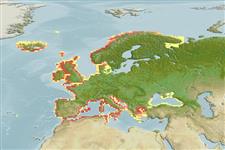Classification / Names
Common names from other countries
Main reference
Size / Weight / Age
Max length : 600 cm TL male/unsexed; (Ref. 59043); common length : 125 cm TL male/unsexed; (Ref. 3397); max. published weight: 400.0 kg (Ref. 556); max. published weight: 400.0 kg; max. reported age: 100 years (Ref. 556)
Length at first maturity
Lm ?, range 165 - ? cm
Environment
Marine; freshwater; brackish; demersal; pH range: 7.5 - ? ; dH range: 10 - 20; anadromous (Ref. 51243); depth range 4 - 93 m (Ref. 51346), usually 5 - 60 m (Ref. 26160)
Climate / Range
Temperate; 10°C - 18°C (Ref. 2059), preferred 6°C (Ref. 107945); 71°N - 34°N, 25°W - 42°E (Ref. 59043)
Distribution
Eastern Atlantic: the only remaining spawning population occurs in the Garonne drainage in France (Ref. 59043, 89072). Used to range from Norway to the Bay of Biscay, including the North Sea, European coasts of Atlantic, northern Mediterranean eastward to Rhodos, western and southern Black Sea; occasionally recorded from the White Sea, Iceland, Morocco and Algeria. Anadromous, in most large rivers, but not recorded from Danube upriver of delta. Recent DNA studies using museum specimens revealed that this species co-exists with A. naccarii from the Adriatic Sea to the Iberian Peninsula (Ref. 52173). Several DNA sequence differences were found between individuals of the species from the Gironde River population and from the North and Baltic Seas showing that different populations of A. sturio are genetically divergent (Ref. 82476). Appendix II of the Bern Convention (2002). Appendix I and II of the Bonn Convention (2009). Annex II and IV of the EC Habitats Directive (2007). International trade banned (CITES I, since 29.7.83; CMS Appendix II).
Countries | FAO areas | Ecosystems | Occurrences | Introductions
Short description
Dorsal
spines
(total): 0;
Dorsal
soft rays
(total): 30-44;
Anal
spines: 0;
Anal
soft rays: 23 - 30. Body elongated, pentagonal section (Ref. 51442). Snout moderate with tip narrow and pointed (Ref. 3397), mouth inferior (Ref. 59043). Lower lip not continuous, interrupted at center (Ref. 3397). Four barbels halfway between snout tip and mouth but not reaching the latter (Ref. 3397, Ref. 51442). No scales, but 5 rows of scutes on the body: dorsal 9-16, lateral 24-39 on each side, ventral 9-14 on each side, with dense cross-lines of smaller rhombic plates between the dorsal and lateral rows (Ref. 2196, Ref. 3397, Ref. 40476, Ref. 51442). Dorsal side greenish-brown to blackish with golden tints, flanks light with silvery tints, belly white (Ref. 3397).
IUCN Red List Status (Ref. 115185)
Threat to humans
Harmless
Human uses
Fisheries: commercial; aquaculture: commercial
Tools
Special reports
Download XML
Internet sources
Estimates of some properties based on models
Phylogenetic diversity index
PD50 = 0.5000 many relatives (e.g. carps) 0.5 - 2.0 few relatives (e.g. lungfishes)
Trophic Level
3.5 ±0.51 se; Based on food items.
Resilience
Very Low, minimum population doubling time more than 14 years (tm=7-20; tmax=100)
Vulnerability
Very high vulnerability (88 of 100)
Price category
